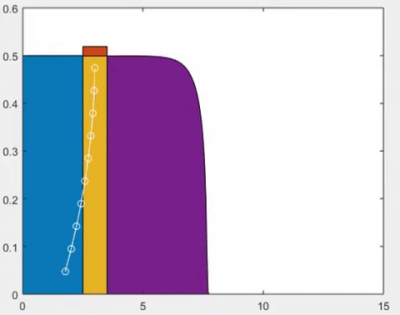Elliott Kauffman '22 - Duke Opportunities in Mathematics (DOmath) Program (Summer 2019)
Elliott Kauffman '22 - Duke Opportunities in Mathematics (DOmath) Program (Summer 2019)

This summer I participated in the DOmath research program for 8 weeks this summer, for which SPIRE helped assist me in my housing expenses. I worked on a project entitled “Dynamics of Floating Plates on Thin Films” with another student, Daniel Hwang, under the mentorship of Dr. Thomas Witelski, Dr. Jeffrey Wong, and Jingzhen Hu. In our work we considered the problem of a rigid plate floating on a viscous fluid film down an inclined plane. Many similar problems have been previously investigated, because these problems have many real-world applications. For example, this problem model can be used to describe the motion of contact lenses or the motion of a surfboard. We used the Navier-Stokes equations of fluid dynamics to derive differential equations that described the problem, then used MATLAB to numerically solve those differential equations and simulate the physics of the problem.
The main challenge with this problem was that the differential equations of each region in the problem required cyclical input from other regions, necessitating a numerical simulation. The free-flow regions provided information about the motion of the plate and the fluid underneath and vice versa. In addition to using differential equations to describe the progression of the fluid’s motion, we also derived differential equations that described the motion of point-like particles dispersed throughout the fluid. We discovered through numerically tracking test points within the fluid body that points within the fluid never surpass the horizontal position of the plate floating on top of the fluid. We also discovered that the differential equations can be simplified by ignoring vertical forces so that an analytical solution can be obtained. This analytical solution is sufficient to describe the motion of the rigid plate up until the plate’s maximum horizontal velocity. After this point, the vertical motion of the plate becomes important in describing the entire motion of the plate and the fluid beneath. We found that as the density of the plate decreases, the plate’s horizontal velocity more accurately follows the simplified model up until its peak. We also discovered that as the length of the plate increases, the terminal vertical velocity of the plate reaches zero, indicating that the presence of the plate itself affects the motion of the fluid underneath.
I greatly appreciated SPIRE’s support for this research experience. Through this experience, I have gained knowledge about working with numerical methods of solving differential equations, coding, and fluid mechanics. This experience is extremely applicable to my goals as a physics major at Duke and I am excited for possible future endeavors that DOmath may have opened up for me.



